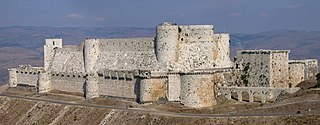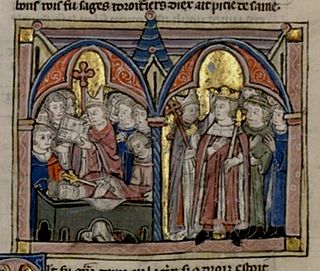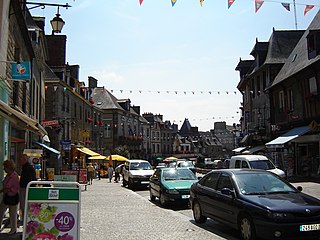Related Research Articles

John was King of England from 1199 until his death in 1216. He lost the Duchy of Normandy and most of his other French lands to King Philip II of France, resulting in the collapse of the Angevin Empire and contributing to the subsequent growth in power of the French Capetian dynasty during the 13th century. The baronial revolt at the end of John's reign led to the sealing of Magna Carta, a document sometimes considered an early step in the evolution of the constitution of the United Kingdom.

Richard I was King of England from 1189 until his death in 1199. He also ruled as Duke of Normandy, Aquitaine and Gascony, Lord of Cyprus, and Count of Poitiers, Anjou, Maine, and Nantes, and was overlord of Brittany at various times during the same period. He was the third of five sons of King Henry II of England and Eleanor of Aquitaine and seemed unlikely to become king, but all his brothers except the youngest, John, predeceased their father. Richard is known as Richard Cœur de Lion or Richard the Lionheart because of his reputation as a great military leader and warrior. The troubadour Bertran de Born also called him Richard Oc-e-Non, possibly from a reputation for terseness.

Year 1188 (MCLXXXVIII) was a leap year starting on Friday of the Julian calendar.

Year 1174 (MCLXXIV) was a common year starting on Tuesday of the Julian calendar, the 1174th year of the Common Era (CE) and Anno Domini (AD) designations, the 174th year of the 2nd millennium, the 74th year of the 12th century, and the 5th year of the 1170s decade.

Geoffrey II was Duke of Brittany and 3rd Earl of Richmond between 1181 and 1186, through his marriage with the heiress Constance. Geoffrey was the fourth of five sons of Henry II, King of England and Eleanor, Duchess of Aquitaine.

The First Barons' War (1215–1217) was a civil war in the Kingdom of England in which a group of rebellious major landowners led by Robert Fitzwalter waged war against King John of England. The conflict resulted from King John's disastrous wars against King Philip II of France, which led to the collapse of the Angevin Empire, and John's subsequent refusal to accept and abide the "Magna Carta", which he had sealed on 15 June 1215.

Château Gaillard is a medieval castle ruin overlooking the River Seine above the commune of Les Andelys, in the French department of Eure, in Normandy. It is located some 95 kilometres (59 mi) north-west of Paris and 40 kilometres (25 mi) from Rouen. Construction began in 1196 under the auspices of Richard the Lionheart, who was simultaneously King of England and feudal Duke of Normandy. The castle was expensive to build, but the majority of the work was done in an unusually short period of time. It took just two years and, at the same time, the town of Petit Andely was constructed. Château Gaillard has a complex and advanced design, and uses early principles of concentric fortification; it was also one of the earliest European castles to use machicolations. The castle consists of three enclosures separated by dry moats, with a keep in the inner enclosure.

Walter de Coutances was a medieval Anglo-Norman bishop of Lincoln and archbishop of Rouen. He began his royal service in the government of Henry II, serving as a vice-chancellor. He also accumulated a number of ecclesiastical offices, becoming successively canon of Rouen Cathedral, treasurer of Rouen, and archdeacon of Oxford. King Henry sent him on a number of diplomatic missions and finally rewarded him with the bishopric of Lincoln in 1183. He did not remain there long, for he was translated to Rouen in late 1184.
Pierre Basile, also named Bertran de Gurdun and John Sabroz, was a Limousin boy famous for shooting King Richard I of England with a crossbow at the siege of Châlus-Chabrol on March 25, 1199. King Richard, who had removed some of his chainmail, was not mortally wounded by Basile's bolt; however, the wound resulted in gangrene.

The Angevin Empire describes the possessions of the Angevin kings of England who held lands in England and France during the 12th and 13th centuries. Its rulers were Henry II, Richard I (r. 1189–1199), and John (r. 1199–1216). The Angevin Empire is an early example of a composite state.
Hugh de Puiset was a medieval Bishop of Durham and Chief Justiciar of England under King Richard I. He was the nephew of King Stephen of England and Henry of Blois, who both assisted Hugh's ecclesiastical career. He held the office of treasurer of York for a number of years, which led him into conflict with Henry Murdac, Archbishop of York. In 1153, Hugh was elected bishop of Durham despite the opposition of Murdac.
Philip of Poitou was Bishop of Durham from 1197 to 1208, and prior to this Archdeacon of Canterbury.

Dol-de-Bretagne, cited in most historical records under its Breton name of Dol, is a commune in the Ille-et-Vilaine département in Brittany in northwestern France.

Matthew, Count of Boulogne, also known as Matthew of Alsace was the second son of Thierry, Count of Flanders and Sibylla of Anjou. Matthew forcibly abducted the nun Marie de Boulogne, daughter of Stephen, King of England, and constrained her into marriage, claiming the title of Count of Boulogne jure uxoris in 1160. The forced marriage was opposed by the Church and finally annulled in 1170, but he continued to rule as count until his death.

England in the High Middle Ages includes the history of England between the Norman Conquest in 1066 and the death of King John, considered by some to be the last of the Angevin kings of England, in 1216. A disputed succession and victory at the Battle of Hastings led to the conquest of England by William of Normandy in 1066. This linked the crown of England with possessions in France and brought a new aristocracy to the country that dominated landholding, government and the church. They brought with them the French language and maintained their rule through a system of castles and the introduction of a feudal system of landholding. By the time of William's death in 1087, England formed the largest part of an Anglo-Norman empire, ruled by nobles with landholdings across England, Normandy and Wales. William's sons disputed succession to his lands, with William II emerging as ruler of England and much of Normandy. On his death in 1100 his younger brother claimed the throne as Henry I and defeated his brother Robert to reunite England and Normandy. Henry was a ruthless yet effective king, but after the death of his only male heir William Adelin in the White Ship tragedy, he persuaded his barons to recognise his daughter Matilda as heir. When Henry died in 1135 her cousin Stephen of Blois had himself proclaimed king, leading to a civil war known as The Anarchy. Eventually Stephen recognised Matilda's son Henry as his heir and when Stephen died in 1154, he succeeded as Henry II.

Château de Chinon is a castle located on the bank of the river Vienne in Chinon, France. It was founded by Theobald I, Count of Blois. In the 11th century the castle became the property of the counts of Anjou. In 1156 Henry II of England, a member of the House of Anjou, took the castle from his brother Geoffrey, Count of Nantes, after Geoffrey rebelled for a second time. Henry favoured the Château de Chinon as a residence. Most of the standing structure can be attributed to his reign; he died there in 1189.

Henry II, also known as Henry Curtmantle, Henry FitzEmpress or Henry Plantagenet, was King of England from 1154 until his death in 1189. He was the first king of the House of Plantagenet. King Louis VII of France made him Duke of Normandy in 1150. Henry became Count of Anjou and Maine upon the death of his father, Count Geoffrey V, in 1151. His marriage in 1152 to Eleanor of Aquitaine, whose marriage to Louis VII had recently been annulled, made him Duke of Aquitaine. He became Count of Nantes by treaty in 1185. Before he was 40 he controlled England, large parts of Wales, the eastern half of Ireland and the western half of France; an area that was later called the Angevin Empire. At various times, Henry also partially controlled Scotland and the Duchy of Brittany.

The Angevins were a royal house of French origin that ruled England in the 12th and early 13th centuries; its monarchs were Henry II, Richard I and John. In the 10 years from 1144, two successive counts of Anjou in France, Geoffrey and his son, the future Henry II, won control of a vast assemblage of lands in western Europe that would last for 80 years and would retrospectively be referred to as the Angevin Empire. As a political entity this was structurally different from the preceding Norman and subsequent Plantagenet realms. Geoffrey became Duke of Normandy in 1144 and died in 1151. In 1152 his heir, Henry, added Aquitaine by virtue of his marriage to Eleanor of Aquitaine. Henry also inherited the claim of his mother, Empress Matilda, the daughter of King Henry I, to the English throne, to which he succeeded in 1154 following the death of King Stephen.
The Battle of Fréteval, which took place on 3 July 1194, was a medieval battle, part of the ongoing fighting between Richard the Lionheart and Philip II of France that lasted from 1193 to Richard's death in April 1199. During the battle, the Anglo-Norman and Angevin forces ambushed the French army, which was defeated. Philip managed to flee but lost his archives which were captured by Richard. After the battle, Philip decided to keep them in Paris, which led to the creation of the French national library, the Archives Nationales.

Lancaster's chevauchée of 1346 was a series of offensives directed by Henry, Earl of Lancaster, in southwestern France during autumn 1346, as a part of the Hundred Years' War.
References
- Notes
- ↑ Notes historiques du chanoine DURENGUES [ permanent dead link ](in French)
- 1 2 Warren 1978 , pp. 231–232.
- ↑ Gillingham 2002 , p. 52.
- ↑ Flori 1999 , pp. 41–42.
- Bibliography
- Flori, Jean (1999), Richard the Lionheart: Knight and King, translated by Jean Birrell, Edinburgh: Edinburgh University Press, ISBN 978-0-7486-2047-0
- Gillingham, John (2002) [1999], Richard I, London: Yale University Press, ISBN 0-300-09404-3
- Warren, Wilfred Lewis (1978), Henry II , University of California Press, ISBN 978-0-520-03494-5
Coordinates: 44°12′32″N0°39′9″E / 44.20889°N 0.65250°E